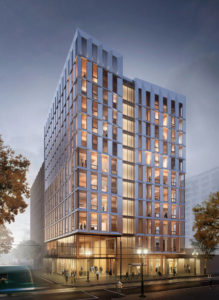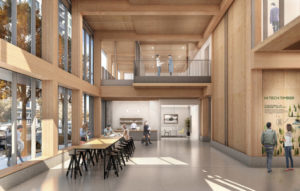
Images courtesy LEVER Architecture
Earlier this month, Framework Project LLC announced the State of Oregon and City of Portland had awarded it approval to build the United States’ first wood high-rise building. Framework will stand 12 stories on completion, and will incorporate mass timber materials including cross-laminated timber (CLT) and glue-laminated timber (glulam). Its construction will begin in the fall and be completed by the following winter. (To read more about the project, see the article in the February 2017 issue of The Construction Specifier.)
“Receiving a permit is a critical juncture for Framework and demonstrates the feasibility of using wood to build high-rise buildings in the U.S.,” said Anyeley Hallova, a developer with project^. “With our path now clear to start building, Framework will start to unlock the demand for mass timber products at all scales, justifying new investment into rural manufacturing and job creation.”
Job creation is predicted to be one of the effects of Framework’s completion, given the fact its construction may lay the groundwork for more mass timber projects in the future. An upcoming Oregon Built Environment & Sustainable Technologies (BEST) study also estimates labor income from mass timber manufacturing could range from $338 million to $1 billion per year in Oregon, along with creating 5800 to 17,300 direct, indirect, and induced jobs.
“The Framework project is literally a laboratory for the revival of building with mass timber—an investment for which Oregonians will be grateful for many generations to come,” said Valerie Johnson, president of the project’s CLT manufacturer. “The rural-urban divide in Oregon has existed too long. We hope our young people [in Douglas County] will now grow up believing there’s a future for them doing this type of work. It’s inspiring for all of us to know that all together we are providing a more environmentally friendly, lower-carbon-emitting, renewable, and sustainable product for mass timber construction in urban areas.”
Testing completed last year indicates other benefits of building with mass timber as well, such as the material’s ability to exceed fire and life safety code requirements. Portland State University and Oregon State University also completed seismic tests on Framework’s primary beam-to-beam connection and CLT shear wall panels, to confirm the building’s ability to exceed life safety requirements. In the event of a major earthquake, the structure should suffer only minimal damage.
“Projects like the Framework building present a new opportunity for Oregon that we are perfectly suited to take on. Oregon’s forests are a tried-and-true resource that may again be the key to economic stability for rural Oregon, expanding opportunity for communities hit hard by the decline of the natural resource economy,” said Kate Brown, governor of Oregon. “The Framework building shows that we can use sustainably harvested timber in a sustainable way to act as a catalyst for economic development through the creation of timber and manufacturing jobs in rural economies.”

The building will be the country’s first high-rise wood building, as well as its tallest mass timber building. Further, it will be the tallest post-tensioned rocking wall project in the world. It will contain office, retail, and affordable housing space, as well as dedicating some space to a tall wood exhibit.
“Portland is built on creative innovation and the trailblazing spirit as exemplified by the groundbreaking work of the Framework Project,” said Ted Wheeler, the city’s mayor. “Thanks to the tremendous work of the Framework team, Portland’s Pearl District will proudly stand as the site of the first skyscraper made from wood in the United States—a true technological and entrepreneurial achievement.”





“Skyscraper” is 50 or more stories tall. This project would be called mid rise at best.
Per code high-rise is correct
Is is fire safe? In light of recent disasters such as the skyscraper which burned and killed many people in Britain, may not be as safe as reinf conc. or protected steel.
There is a lot to still discuss about this project. Are you creating 5,800 – 17,300 jobs in a different sector, but eliminating the same in another field? What is the net gain in jobs? Multi-family and multi-use buildings, especially taller ones, should be built with non-combustible materials. I don’t care what you do with wood, it is a combustible material. What is the insurance premium difference compared to a non-combustible building? Taking advantage of lax codes does not make a safe building fire-safe. I think it is irresponsible. There is a reason that we’ve abandoned wood construction in a lot of situations. It has a place in single-family homes.
Sorry but I do not agree, this is structural wood which has higher fire resistance than steel prior to collapsing which will do in slow motion as opposite to steel which will collapse immediately after reaching melting point. It is also biodegradable, sustainable and recyclable. This building is a brave attempt to create a new paradigm with a noble building material that most people think “has a place in single-family homes”, only, or is ” irresponsible” to use. Large public building are currently built in Austria, Switzerland and Germany in wood, specially structural glu-lam that have high fire resistance and sprinklers that meet much more stringent building codes. The reason is that they have a much lower impact on the environment and definitely create more local jobs, as opposite to steel and cement imports from abroad, which use production methods that are detrimental to the environment and create jobs somewhere else.